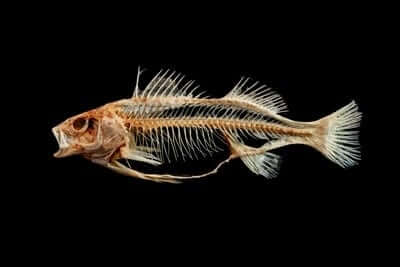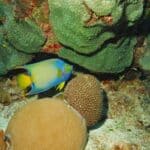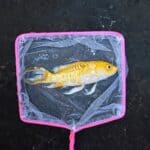Last Updated on: 5th November 2023, 02:27 pm
Fish are vertebrates, which means they have backbones.
The backbone protects their soft organs and spinal cord, helps them swim, and attaches to their muscles. It also supports the production of blood cells and platelets.
There are two backbone structures: the trunk vertebrae and the caudal spine.
Fish are split into 3 species, depending on their spinal anatomy. The species include jawless, bony, and cartilaginous fish. The backbone structure differs slightly, but the components are the same.
Do Fish Have Spines?
Most fish have backbones, but not all species do.
Bony fish have a chordate body structure, which means they have a stiff rod called the vertebral column (or notochord) running through the length of their bodies.
The spinal cord, a hollow tube containing nervous tissue, is just above it. The gastrointestinal tract lies underneath the backbone.
Examples of bony fish include:
- Clownfish.
- Tuna.
- Catfish.
- Zebrafish.
- Goldfish.
The vertebral column comprises a segmental series of stiff bones (the vertebrae) separated by mobile joints called interverbal discs.
The vertebral column consists of the:
- Centrum: The structural core of the vertebra. It’s usually concave at each end, limiting motion.
- Vertebral arches: These protrude from the top and bottom of the centrum
The Laboratory of Biological Structures Mechanics explains how the vertebral column differs:
- Trunk vertebrae are connected to the ribs and feature a neural arch and spines.
- The caudal spine has no ribs but a hemal arch (chevron), which protects the caudal artery and vein.
Lobed-finned fish – a clade of bony fish with fleshy, paired fins joined to the body with a single bone – have three bony elements in their vertebrae.
These bones include the following:
- The vertebral arch surrounds the spinal cord.
- The pleurocentrum protects the upper surface of the notochord.
- The intercentrum is an arch-shaped bone protecting the lower border.
In ray-finned fish, the pleurocentrum and intercentrum are fused and embedded with a solid piece of bone that resembles a mammal’s vertebral body.
Cartilaginous fish (e.g., sharks and stingrays) have vertebrae consisting of two cartilaginous tubes.
Vertebral arches form the upper tube, but additional structures comprised of cartilage fill in the vertebrae gaps. The lower tube surrounds the notochord and includes layers of calcification.
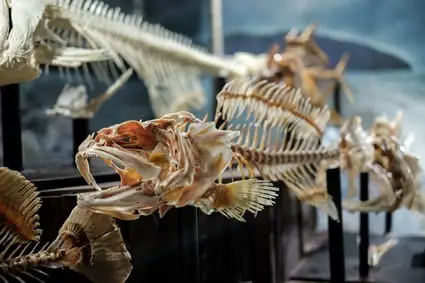
Are Fish Vertebrate or Invertebrate?
As fish have backbones, they’re vertebrates like mammals, amphibians, reptiles, and birds.
There are approximately 66,000 vertebrate animal species. While this sounds like a large number, this is only 3% of the world’s population.
Invertebrates have soft bodies or a hard outer casing that protects their bodies.
Why Do Fish Have Backbones?
The spine supports all other bones, body parts, vital organs, and muscles. The vertebral column is the body’s main structure.
As described by Science Direct, the vertebral column:
- Provides attachment to the muscles.
- Supports the trunk.
- Protects the spinal cord and nerve roots.
- Supports the production of blood cells and platelets (hemopoiesis).
Fish backbones are vital for the following reasons:
Supports The Body
The backbone is a fundamental part of the skeleton, supporting the soft and delicate organs. It also supports the fins, which extend from the spine and perform several crucial swimming functions.
The backbone is responsible for propping up the area between (and including) the head and trunk.
Fish have two ribs, which are attached directly to the upper and lower part of the spine. This means that after the skull, the backbone is the most vital part of the skeletal system.
Protects Organs
The spinal cord is fragile. Not only does the backbone support the organs, but it protects them.
Fish need their spines in good working order because they have many nerves that send information to the brain and other body parts, acting as a messaging pathway between the brain and the body.
The spinal cord runs through the spine, so the bony structure protects it. Without healthy, efficient backbones, fish wouldn’t move properly and would struggle to survive.
Movement
The backbone helps fish swim. While the fins and tail play an essential role in how fish move through the water, the backbone enables it to happen in the first place.
Most body parts and organs that aid movement are connected to the backbone. Fish engage their spine when they want to move, steer, and change direction.
Structure
The backbone determines the shape of the fish. Like all chordates, the body takes after the spine. Without it, fish wouldn’t have structure, and their organs would be vulnerable to accident and injury.
What Fish Don’t Have Backbones?
While most fish have backbones, some species lack spines.
Fish without backbones include:
- Bony fish.
- Jawless fish.
- Cartilaginous fish.
While almost all fish have some bony spinal structure, some don’t. These include:
Hagfish
Hagfish are shaped similarly to eels and have four pairs of thin sensory tentacles around their mouths that they use to find food. When they find a meal, they bury it with their faces and tunnel into its flesh.
Smithsonian Magazine describes how hagfish are considered a part of the jawless fish species, but no one is sure whether they belong to their group between invertebrates and vertebrates.
Even though they have a partial cranial skull, hagfish lack a backbone. That’s why they can’t be classed as true vertebrates. Hagfish don’t have any bones, as their skeletons comprise cartilage.
They share many traits with vertebrates, including jaws, an enlarged head, and a well-developed sensory system. Out of all sea creatures, hagfish are most akin to lampreys.
As described by the Laboratory of Biological Structures Mechanics, a rudimentary spine that develops in the embryo with the same mechanisms found in other vertebrates exists.
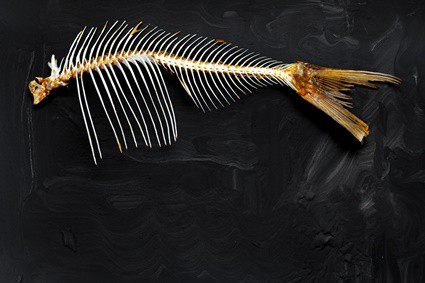
Lancelets
Though lancelets aren’t a fish species, they’re considered close to vertebrate ancestral lineage.
They contain organs and organ systems that resemble modern fish, but they’re more primitive. They have a hollow nerve cord running along the back, pharyngeal slits, and a tail that runs past the anus.
While they have a nerve cord, it’s not protected by bone but by a notochord. This differs from that of an invertebrate, as it’s more straightforward in structure.
It comprises tightly packed cylinders of cells. Also, a lancelet’s notochord extends into the head.
Lamprey
Lampreys closely resemble eels. They have long, scaleless bodies, a solitary nostril on the top of their head, and 7 gill pores on each side.
Like hagfish, lampreys have a cartilaginous skeleton. They also have several cartilaginous structures called arcualia. These are located above the notochord, meaning lampreys aren’t true vertebrates.
Despite this, they’re some of the most energy-efficient swimmers in the ocean. Their movements generate low-pressure zones around the body, pulling their bodies through the water instead of pushing them.
Fish are closer in anatomy to humans than you might think. Their backbones are among their most essential features, and without them, they wouldn’t survive.

